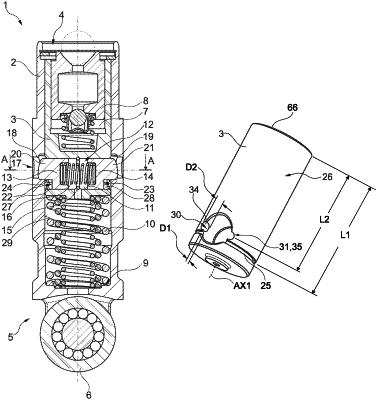| CPC F01L 1/14 (2013.01) [F01L 1/2422 (2013.01); F01L 1/46 (2013.01)] | 20 Claims |

|
6. A switching element for a valve train of an internal combustion engine, the switching element comprising:
an external part;
an internal part, configured to be: i) axially displaced in a bore of the external part and, ii) -displaced relative to the external part into a coupling position in which at least one radially extending receptacle of the internal part overlaps with at least one radially extending recess of the external part; and
at least one locking element slidably guided within the at least one radially extending receptacle, the at least one locking element having a flattened portion on a radially outwardly directed end; and
a locking section defined on the flattened portion of the at least one locking element, the locking section engaging in the at least one radially extending recess of the external part in a locking position of the at least one locking element and in the coupling position of the internal part and the external part; and
the at least one radially extending recess of the external part is configured to be acted upon by a control pressure and the at least one locking element is configured to be radially displaced from the locking position to a release position, in which the at least one locking element is displaced radially inwardly via the control pressure into the at least one radially extending receptacle; and
at least in the locking position of the at least one locking element, a chamber delimited by the at least one locking element is spatially separated from the at least one radially extending recess of the external part by the locking section; and
when the locking section is in axial contact with the external part in the locking position, at least one bypass is arranged to indirectly fluidly connect the at least one radially extending recess of the external part to the chamber at least until the chamber is fluidly connected directly to the at least one radially extending recess during a course of displacement of the at least one locking element; and
the at least one bypass is formed by a cut-out arranged on or within the at least one locking element.
|